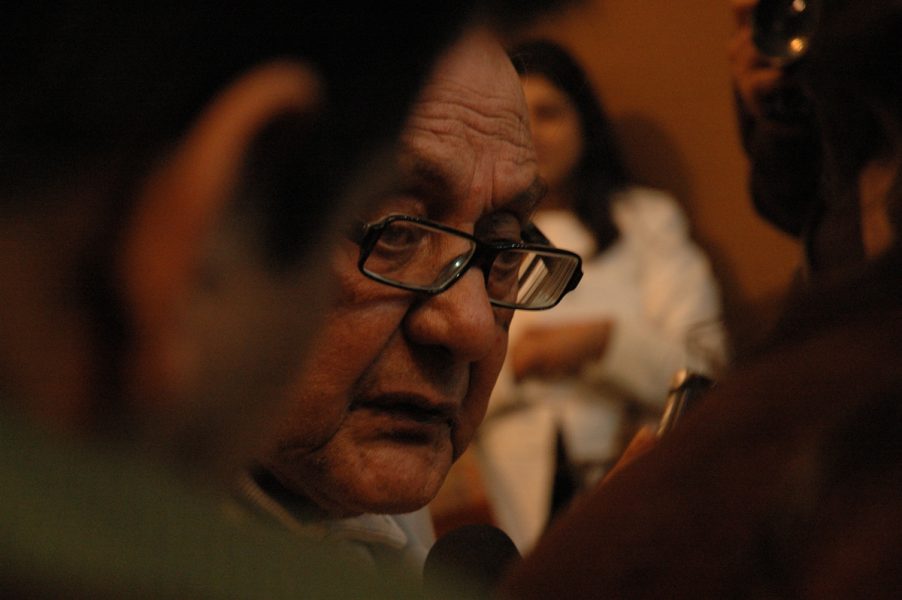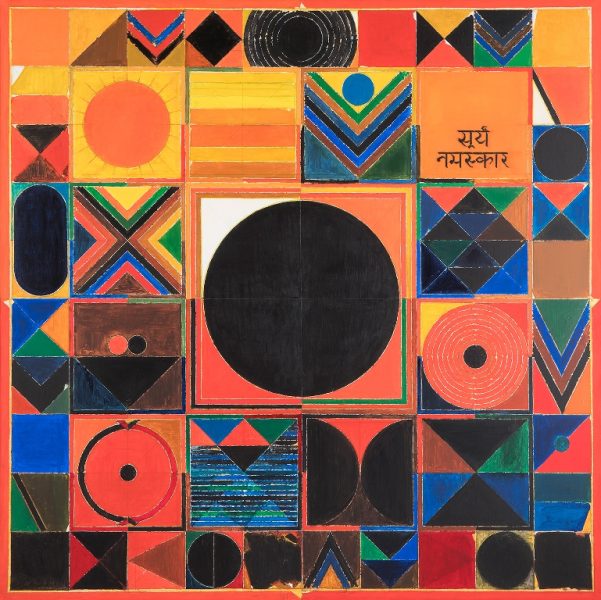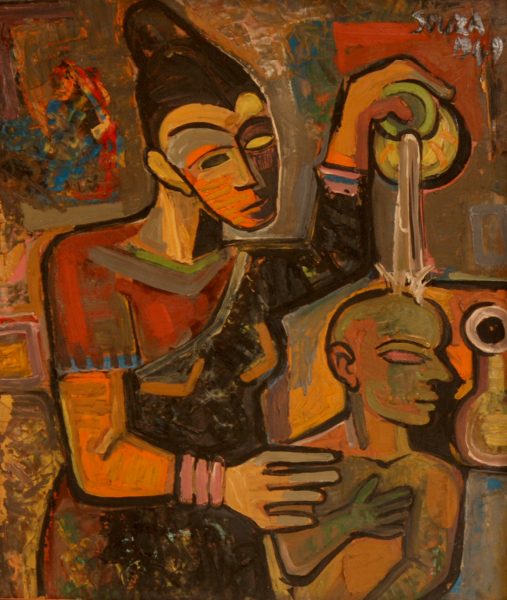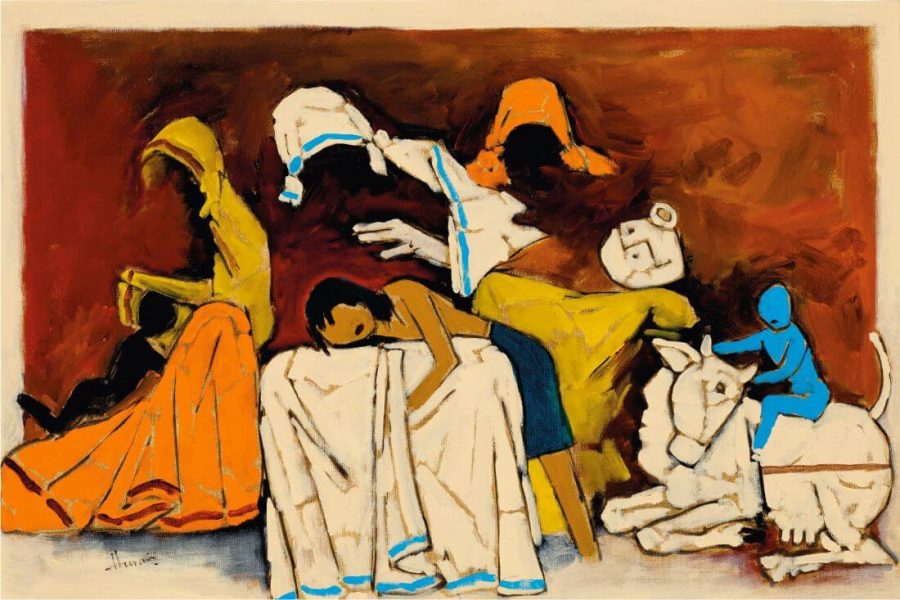
How SH Raza and Progressive Artists’ Group put India on international art map

Four years before he died in 2016, I had asked Sayed Haider (SH) Raza, the legendary artist who would have been 101 today, how he would want to be remembered as. “I would like to be remembered as a painter who tried to explore life, art and existence in our time,” he had replied.
At 90, Raza said he was content with life. He had aspired to be a painter and ultimately had the satisfaction of being one, painting his visions of life and reality in distinctive geometric abstracts, specially bindus (dots), soaked in bursts of bright colours. Since he had dealt with ideas like space and time, and existence and creation in his work, had he reached any conclusion vis-à-vis creation and its purpose? “An artist never reaches, he always travels. Creation, I believe, is its own purpose,” he had said.
Raza’s work, he often said, was a product of his inner experience and involvement with the mysteries of nature and form, which found expression in colour, line, space and light. As part of his centenary celebrations, the Raza Foundation and Dhoomimal Gallery (DMG) have organised a retrospective of his 98 works — sourced from art institutions and private collectors across India and Europe — at Pompidou Centre in Paris, which opened on February 15 and will be on till May 15.
Also read: I come from an orphaned city, with a murdered background: Asmaa Azaizeh
To complement it, DMG has also organised “Raza & His Contemporaries” — an exhibition of works by Raza and other founding members of the Progressive Artists’ Group (PAG), which was formed in Bombay in 1947 and became instrumental in the evolution of modern Indian art in a nation striving for a selfhood. The works are drawn from Ravi Jain Collection of modern Indian art; DMG’s state-of-the-art 5,000 sq.ft. space at Connaught Circus in Delhi also houses the Ravi Jain Centre for International Arts. The exhibition opened on February 3 and will be on till March 10.

Signposts for a new nation
“Raza’s works heralded modernism and were signposts for the new nation that was coming into being. They also paved the path for modern Indian art,” art historian and author Yashodhara Dalmia, who has curated the show at DMG, told The Federal. Along with celebrating Raza’s journey, the show also puts the spotlight on other iconic artists and his fellow PAG founding members: M.F. Husain, F.N. Souza, K.H. Ara, S. Bakre and H.A. Gade. Besides, it also celebrates the simultaneous emergence of influential artists of his time — like J. Swaminathan, K.G. Subramanyan, Pradosh Dasgupta, Biren De, Jamini Roy and Zarina Hashmi — on the nascent Indian art scene. The 20 masters whose works are on display at the show belonged to the grand generation of Indian artists, who achieved excellence in art and placed India on the international art map.
“They played a crucial role in overthrowing the notions of academic art and creating a strong bid for liberalizing the art practice, thus shaping modernism in Indian art,” says Dalmia, whose biography of Raza, Sayed Haider Raza: The Journey of an Iconic Artist, was published by HarperCollins India in 2021.
The vocabulary of colours
Born in a barley settlement Barbaria in Madhya Pradesh’s Narsinghpur district, Raza arrived in Bombay at the age of 21. He stayed in the city between 1943 and 1950, before moving to Paris, where he spent most of his life. It was a period of great resurgence and cultural awakening and Raza got introduced to several like-minded artists like Akbar Padamsee, Tyeb Mehta and V.S. Gaitonde. “These seven years of my life and work were a sort of awakening, a realization of the real values involved in painting. The idea of nature, the impact of nature from childhood, was an important element. But in Bombay I realized that a painter should know his language as a writer should know the vocabulary, the grammar, the meaning of words and has to have a mastery of them in verbal expression. A painter should know what colour is; he should know the organization of colours, their values, and how to render a theme on paper, or on canvas,” Raza stated once.

Raza and his contemporaries, says Dalmia, paved the path for several Indian artists after them. “They broke away from the prevalent academic school of painting. They broke all the rules and created a new form of art. There was a great deal of opposition, but they took up the challenge and fought even when they were living a hand-to-mouth existence,” says Dalmia, adding that Raza and his contemporaries created a vocabulary that was distinctly international. “They created the alphabets and the vowels of art, which was followed by artists after them.” When you see their works together, you find how original the heritage they have created is and the period these fascinating artworks sprang from.
Of the 20 artists, Raza, a polyglot with great interest in Urdu and Hindi literature, blazed the trail with his incandescent use of primary colours. “The Progressive Artists’ Group critiqued the outmoded practices of schools of art and rejected outright the revivalistic approach of the Bengal School. The Group, in its coming together, also symbolized the transcendence of the divisions created by religion, regions and caste,” writes Dalmia in her curatorial note.
The search for significant form
Struggling to eke out a living, the young artists would meet frequently, and hold long discussions late into the night in their quest to find a means of expression in art which would reflect the needs of the country. “The real common denominator for us was significant form. We were expressing ourselves differently, we had different visions during the early days but what was common was a search for significant form, each in his own way, according to his vision. In a painted work, howsoever different it may be, say for example Modigliani and Soutine, who both painted nudes, the approach, the vision is different, the sensibility is different and, of course the temperament of these two artists is different. But the common denominator was significant form,” Raza stated.

Dalmia writes in her note how Souza (1924-2002), who had founded the Group, with his immense distortions and frank exposure of the human body, formed the basic language of a forceful modernism. Through his painted figures, particularly those in authority in the Catholic church — men with soulless eyes in place of forehead, gnashing mouths and faces that resemble a ridged rocky terrain — Souza created the very morphology of the face. Husain (1915 – 2011) captured “the nuances of a lived reality with intimate details of street life.” In his later works, Husain delved into contemporary issues like the cataclysmic violence after the demolition of the Babri masjid or the depiction of Mother Teresa’s manifest compassion.
Also read: Of veins, ink and fire: Kochi-Muziris Biennale’s fifth edition curates resistance
As for Raza, it was the “hot colours of the land” that helped him create mesmeric works redolent with sights and sound of his country. “His paintings, made in brilliant, primary colours, were non-figurative and yet spoke of a passionate, lived reality. The deep, dark circles known as the Bindus were a centrifugal force in his works which drew upon the metaphysical concept of the focal point of concentration shown to him by his school teacher in Madhya Pradesh in his childhood. In his works, we see the interlocking reds and yellows with the deep blacks and browns which create a dynamic surface that is charged with an imperceptible energy,” writes Dalmia, adding that the flaming colours are enveloped within the impending darkness and flit through its fluid surface creating a restless energy. Raza’s works, she underlines, added substantially to the modernist genre and are known for their subliminal exploration of colour as well as for their epiphanic manifestation of universal truths. As one of the founding figures of the Progressive Artists’ Group, Raza laid the tracks for the art movement in the country and placed it on the international map.
In 2012, Raza Foundation had organised a nine-day-long artistic, multi-disciplinary extravaganza in New Delhi to mark Raza’s 90th birthday. It was titled “Aviraam” (non-stop in Hindi), a nod to the artist’s journey that had continued into his late 80s. As most of Raza’s works seem to be reflections of the engagement with his inner self, I had asked him where the realities of the outside world figured. “Inside and outside reality reflect each other. One is invariably the other. I have tried to paint what I consider to be the essence. I dearly hope that the dichotomy of the inner and outer disappears in all arts, including mine,” Raza — who saw the art scene in the second decade of the 21st century as vibrant, and full of youthful vigour and passionate fury — had said.

